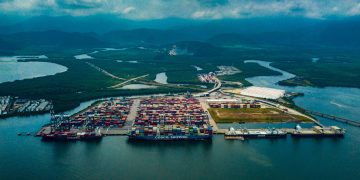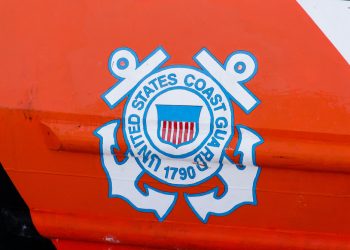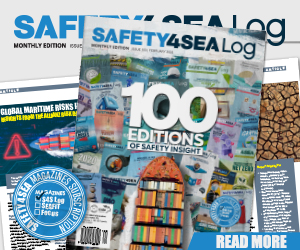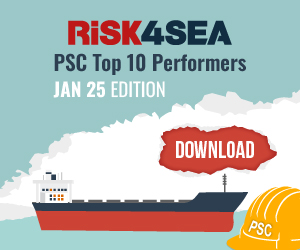Marine environmental protection is one of the Coast Guard’s core missions, and the Coast Guard remains committed to ensuring that U.S. waters are protected by a robust oil spill response network. While traditional oil spill response assets are critical to this network, salvage and marine firefighting services are also important in mitigating the risk of oil spills.
The following article provides a brief background of the Coast Guard’s role in vessel planning for salvage and marine firefighting response and current activity related to implementation of recent salvage and marine firefighting regulations:
The Oil Pollution Act of 1990 requires certain ships to have vessel response plans (VRPs). Vessel owners and operators are charged with identifying spill response resources by contract or other approved means, capable of being on-scene within established timeframes. Because ships move from port to port, owners identify response resources in each captain of the port zone for their area of operations. The number of spills and volume of oil spilled in U.S. waters has substantially decreased with the development of response capability and processes that were implemented for tank vessels by industry and the Coast Guard together.
Timely response activities are key to preventing the escalation of incidents. Because salvage and marine firefighting expertise can both prevent oil spills and minimize threats of spills from escalating, the same VRP resource planning principles were put into place for salvage and marine firefighting services. A long and collaborative development process led to the identification of various distinct salvage and marine firefighting (SMFF) services for assessment, stabilization and special operations. This consultative process resulted in the promulgation of regulations that went into effect in 2009, requiring tank vessels to plan for SMFF services.
Originally applicable to tank vessels, it became apparent that oil spill risks from non-tank vessels increased as the vessels grew in size. In 2013, SMFF services became a required component for non-tank VRPs as well. Today, all vessels which must have a VRP are required to plan for SMFF response services as part of their VRP.
The vessel owner / operator is responsible for determining the adequacy of the resource providers included in their response plan, and must certify in the VRP that the identified SMFF provider meets regulatory criteria. The Coast Guard is responsible for review of the VRPs and notifies the vessel owner / operator of VRP approval, or that the VRP does not meet all the requirements. The applicable regulations for plan approval, review, amendment and appeal are found in 33 CFR §§ 155.1065 and 155.1070 (tank vessels) and 33 CFR §§ 155.5065 and 155.5070 (non-tank vessels).
The documentation process required to capture information for 19 distinct SMFF services in up to 41 captain of the port zones places an administrative burden on the VRP community. The Coast Guard worked to resolve this burden through the establishment of Coast Guard protocol for incorporating repetitive Geographic-Specific Appendix (GSA) information into VRPs by reference. The “core GSA” approach resulted in a significant savings in time for both the development and review of VRPs. Those VRPs not incorporating core GSAs by reference are required to include complete SMFF listings.
To ensure SMFF providers submitted complete and accurate SMFF resource capabilities, as required by VRPs, the Coast Guard instituted a verification program to review each core GSA from 2011 through 2013. Quarterly reviews focused on a subset of related resource services (e.g. firefighting services or emergency towing services) and led to the discovery, and correction, of shortfalls in emergency towing vessel and firefighting resources coverage among other services. The review and subsequent corrective actions improved the overall quality of submitted information.
In order to follow up on the Coast Guard’s initial round of engagement, a full verification of the SMFF core GSA service providers for all 19 SMFF services will be initiated in 2016. The objectives of the 2016 verification are to ensure that resource providers (1) meet SMFF planning and service/capability standards identified in regulation; and (2) can deliver resources/services within regulatory time windows. Unlike the 2011 verification, Coast Guard Headquarters will engage directly with the four core GSA providers rather than using Coast Guard districts and sectors to verify the planning considerations for services/capabilities in each captain of the port zone.
Verifying the four “core” SMFF providers addresses SMFF planning for almost all VRP-required vessels calling in U.S. ports. Verification of the remaining SMFF providers will follow. If a service provider is found, through the course of the 2016 verification, unable to meet the planning standards in a particular COTP zone, they will have a reasonable opportunity, as determined by the Coast Guard, to correct shortfalls or remove a service. The Coast Guard will no longer issue conditional acceptances of core GSAs.
While the full scope of the SMFF regulatory regime remains relatively new, it is clear that significant progress has been made throughout the United States to address vulnerabilities. The progress that has been realized is a direct function of a steady and proactive partnership between the Coast Guard and the salvage industry, which has remained intent on growing capacity and ensuring compliance across U.S. ports. Going forward, this partnership, coupled with the 2016 verification effort, will serve to continue that progress, grow SMFF response capability, increase preparedness and reduce risk in the marine environment.
Source: USCG Blog


































































